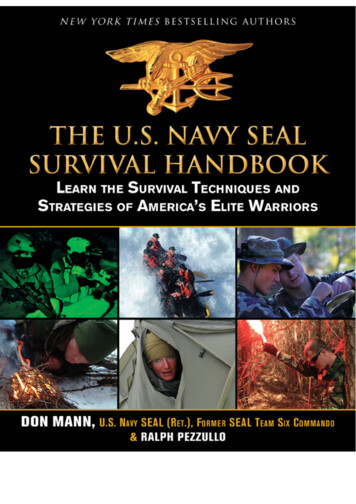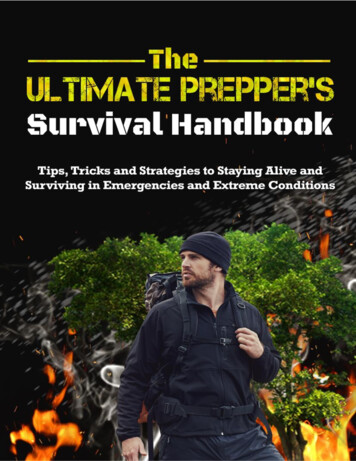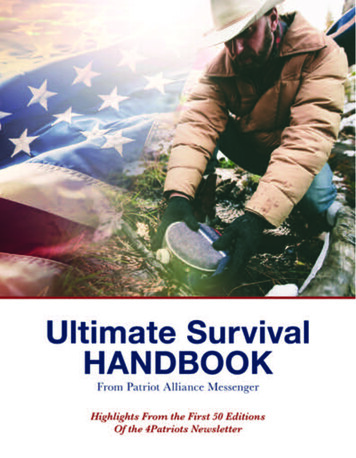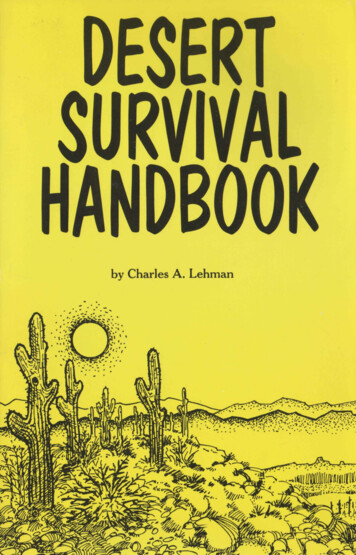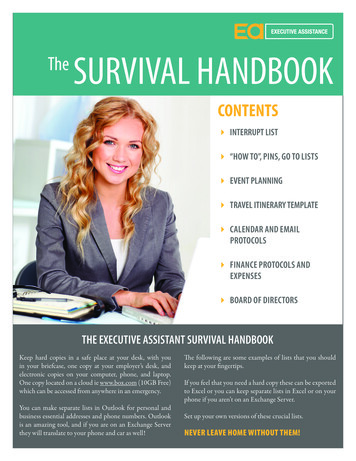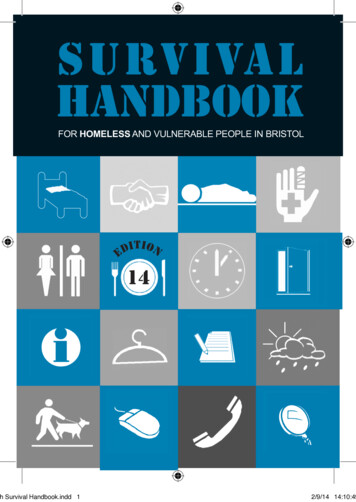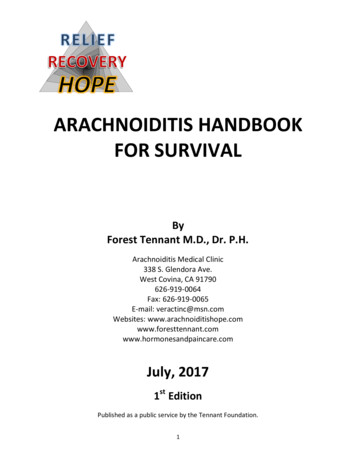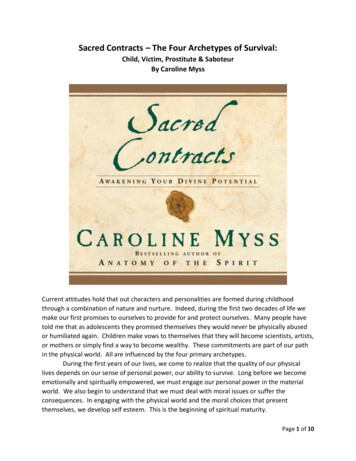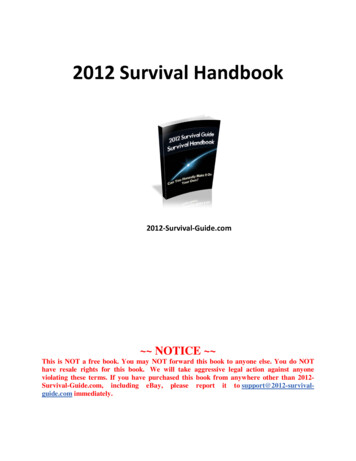
Transcription
2012 Survival Handbook2012-Survival-Guide.com NOTICE This is NOT a free book. You may NOT forward this book to anyone else. You do NOThave resale rights for this book. We will take aggressive legal action against anyoneviolating these terms. If you have purchased this book from anywhere other than 2012Survival-Guide.com, including eBay, please report it to support@2012-survivalguide.com immediately.
Legal DisclaimerThe authors and publishers both disclaim liability regarding any loss or risk incurred as a direct,or indirect, consequence of the application and usage of any of the contents within this guide.CopyrightThose who have received or purchased the guide are neither authorized nor permitted to transmitcopies of this guide to anyone without written permission. Giving away copies to people whohaven’t paid for them is illegal under international copyright laws and will submit you topossible legal action. Therefore, the utilization of this file is limited to personal use only.Terms & DisclaimerBy using, viewing, and interacting with this guide or the 2012-Survival-Guide.com website, youagree to all terms of engagement, thus assuming complete responsibility for your own actions.The authors and publishers will not be held liable or claim accountability for any loss or injuries.Use, view, and interact with these resources at your own risk.All products from 2012-Survival-Guide.com and its related companies are strictly forinformational purposes only. While all attempts have been made to verify the accuracy ofinformation provided on our website and within the publications, neither the authors nor thepublishers are responsible for assuming liability for possible inaccuracies.2 Copyright 2010, 2012 Survival Guide
The authors and publishers disclaim any responsibility for the inaccuracy of the content,including but not limited to errors or omissions. Loss of property, injury to self or others, andeven death could occur as a direct or indirect consequence of the use and application of anycontent found herein.By choosing to use the information made available within any of our publications, you agree toindemnify, defend, and hold harmless the authors, publishers, and any other related companiesfrom all claims (whether valid or invalid), judgments, suits, proceedings, losses, damages, andcosts or expenses of any nature whatsoever that result from the use or misuse of any informationprovided.The information provided may need to be downloaded using third party software, such asAcrobat or Flash Player. It’s the user’s responsibility to install the software necessary to viewsuch information. Any downloads, whether purchased or given for free from our website, relatedwebsites, or hosting systems, are done at the user’s own risk. No warranty is given that websitesare free of corrupting computer codes, viruses or worms.All 2012-Survival-Guide.com information is intended for adults above the age of 18 years only.If you are a minor, you can use this service only with permission and guidance from your parentsor guardians. Children are not eligible to use our services unsupervised. Furthermore, 2012Survival-Guide.com specifically denies access to any individual covered by the Child OnlinePrivacy Act (COPA) of 1998.3 Copyright 2010, 2012 Survival Guide
Table of ContentsPageCopyright & Disclaimer2Urban SurvivalFood/WaterSelf DefenseLocationExtreme Climates5101721274 Copyright 2010, 2012 Survival Guide
Urban SurvivalImagine being trapped inside a war zone. Complete chaos all around you. Peoplerunning, screaming and pillaging anything they can get their hands on.People who aren’t necessarily bad, but scared. Scared beyond any logicalthought. Scared enough to lash out at anything in their path.Now multiply that by a million. Over a million enemies coming at you from allangles. How do you run? Is it possible to hide? What’s the right thing to do tokeep your family safe here?Pre-Step 1. Build A CommunityFirst off, you have to remember that youare all human beings. When stuff hits thefan, it doesn’t change the fact that you’reall in it together. Getting other people tosee that can be relatively easy. Start offby talking to some of your closest friendsand neighbors.There’s safety in numbers, so if you can getCan Be One Of Your Greatest Assets! Be Surea group together before anything goes CommunityTo Choose Your Friends Wisely.down, you’re much better off than tryingto group up afterwards. Plus, your sustainable living area might not be able tosupport a large scale movement.However, if you have the means to setup a large scale settlement, especially withothers, that’s the best thing to do. We humans are meant to live in community(friendship, reproduction, specialized skills and security being just a few reasons)so your survival experience will be much more enjoyable if you start off in acommunity.But what if you don’t have any like-minded people around, or just can’t swing it?5 Copyright 2010, 2012 Survival Guide
Pre-Step 2. Build a RouteCities are complicated places. Major roads are going to be jam packed, andprobably closed. Traffic lights are going to be out. People will be panicking.You need to designate a safe route out of your city. And then drive it. Know itlike the back of your hand.Here are a few things to remember for route planning:1. Stay away from Interstates. They’ll be more like parking lots.2. No lights will be working, so avoidintersections with stop lights if at allpossible.3. Earthquakes, floods and hurricanes changeeverything. Have multiple routes ready.4. Gas stations will be out, but if not willattract huge crowds of people.5. Large bridges can be easily destroyed by Steer Clear Of Bridges, Large Bodies of Water, And The Highestcatastrophic earthquakes. Try to avoid Population Areas!them.Avoid anywhere where large groups of people gather, especially civic centers andfood stores.Also, plan like your route has already been comprised. Have at least three waysout that don’t overlap.6 Copyright 2010, 2012 Survival Guide
Step 1. MobilizeYou should have all of your belongings that you can’t afford to lose already in asecure location. By the time you hit December 21, 2012 if it’s not secured youdon’t have time to grab it.Put your family into the vehicle with each person’sBOB (Bug-Out-Bag). Kids can get by with a smallerbag, but it’s important for each person to be able tohave basic living needs on their back, especially ifyou end up walking.The key here is speed. You should be able to grabeveryone, their BOBs and go in under five minutes ifyou have a dedicated vehicle, and under seven if youhave to fuel your vehicle from your emergency fuelsupply.A Tactical Vehicle Is Perfect ForConvoying To A Secure Location. It’sMore Intimidating And Much HarderFor Anyone To Stop. Be Sure To CarryLarge Quantities of Fuel. Also UpdateThe Technology It Uses As Best YouCan.Step 2. ConvoyYou’ve got to have your route already picked out. If possible, listen to the trafficreport on your radio. If there is any existing technology the government will stillbe trying to use it.Then, based on the data you have (where the disaster has been the worst, what’shappening right now) choose your route. If you don’t have anything to go off of,just pick the route that is the most obscure.7 Copyright 2010, 2012 Survival Guide
What To Do If You Hit ObstaclesFallen trees, destroyed bridges, or sink holes where there used to be a road canmake travel nearly impossible.If you know your area well break out a map and see about circumnavigating theobstacle as quickly as possible.If there’s no possible way to get around it on the route you’re currently heading,double back and head for one of your secondary or tertiary routes.What To Do If You Hit A MobLarge groups of people do rash things. If you have a car, and they don’t you couldbe in trouble.First try to turn and run. If that isn’t possible, fire a few warning shots in the air.While there is confusion, gun your engine and begin honking and flashing yourlights.People’s first instinct when a large object is coming at them at a high rate ofspeed is to get out of the way. Try to avoid hurting anyone and drive through thecrowd as quickly as possible.Step 3. RefuelingDepending on how far outside the city your long-term shelter is, you may have tostop and refuel. A good rule of thumb is to have 2.5 times the amount of fuel youneed to get out alive.That way if you have to double back, or take any large and unexpected detoursyou’ll have enough to make it to your shelter.8 Copyright 2010, 2012 Survival Guide
S.U.R.V.I.V.A.L.Here’s a little acronym to help get you through anything else that might come upin urban survival:Size up the situation.Undue haste makes waste. Calm down, and prepare to act.Remember where you are.Vanquish fear and panic. While you are afraid you will make rash decisions.Rash decisions can kill you and your family.Improvise.Value living. Remember what you have to live for, and hold on to it.Act like the natives. Don’t do anything to stand out if you can help it.Live by your wits. It’s going to take constant thought, but your brain cankeep you alive.These are just general survival principles, but they can make the differencebetween life or death.More thananything else, DON’T PANIC! You’ll onlyget through this if you keep your mindstraight.Not panicking can be hard when everyonearound you is screaming that the sky isfalling, and it feels like it really is. Butremember, you owe it to yourself to You MUST Stay Calm No Matter What Happens. Theminute you panic, you die.remain calm and ordered. Anything elseand you flush your chances of survival down the tubes.9 Copyright 2010, 2012 Survival Guide
2. Food/WaterThis is going to seem like a no brainer, but you can’t survive without food andwater. Once you are out of the city, and to your long-term shelter you’ve got tohave a plan for daily life, especially eating and drinking.How Much Food Do You Need?This is going to sound like a copout, but you cannever have too much food in a safe place. You’realways going to need to eat, and unless you’re onlyplanning on living for a year, you’re going to needmore than a year’s worth of food.My recommendation is to have a minimum of ayour food must have a long shelf life. Grain,year’s worth of food for every person. That way if Allrice, and beans are perfect options.nothing works like you plan it to (crops fail, can’t gooutside, livestock dies, etc) you’ll have time to try again.Hopefully you won’t need it, but better safe than sorry.Worst case scenario, you take your extra food and trade it. Hello position ofpower and prestige right from the get go.What To Include Canned GoodsJerkyDehydrated (Powdered) foodsMREs (Meals Ready to Eat)Meal Replacement BarsBeansRiceFlourGrainPasta10 Copyright 2010, 2012 Survival Guide
What Not To Include Anything with a short shelf lifeProduceFresh vegetablesFoods whose seals have been brokenFood that has to be frozenYou should assume that you’re going to haveto go through this catastrophe with NOELECTRICITY. That means, if you’re countingon your freezer to keep your food preserved,you’re in for a rude awakening. Always relyon dry packed foods.Foods packed in nitrogen or vacuum sealedare great to have. That ensures a long-termshelf life.Bread and other baked goods are a terrific treatwhen you've had nothing but canned foods. Also,it's easy to make and goes well with any meal.Canned foods are also items of choice,because they really can’t go bad unless they get a hole in them or are smashed.That being said, the food inside will get pretty nasty if you wait a long time. It’lllose its texture, taste and most importantly nutritional value.Try to rotate your canned food out every year. In peace times you can donatelarge quantities of canned foods to a food bank and receive a substantial tax writeoff.11 Copyright 2010, 2012 Survival Guide
BakingAs you saw in the vital items list, baking is going to be an excellent source of food.It’s a good stress reliever, and the food will taste terrific, even if you store theflour for extended periods of time.There are two options for baking.Raw BakingThis is where you take all of the basic ingredients andwhip up everything from pancakes to rolls, to breadingfor chicken, to stuffing. There are a ton of options forcombinations of any foods you’ve stored.Plus bread has been a staple for years.A dutch oven can bake practicallyanything you need as long as youhave an open flame or way to heat it.Here are the ingredients you need for any raw baking: Flour (or grain and grain mill)Baking PowderSugar (shorter term)Baking SodaOil (I use olive oil)ShorteningHoney (longer term)Dehydrated EggsBaking MixesBaking mixes can be a great alternative to raw baking. Normally packages ofbaking mixes have a long shelf life.Also, you won’t have to mix any egg powder into them. Just pour in water and go.The thing you’ll need while baking anything is a Dutch oven or griddle for thestove your fire place you’ll be using.12 Copyright 2010, 2012 Survival Guide
Survival FoodsMREs will be the first thing that comes to mind here, but they really aren’t thebest option. While they’re perfect for hiking or short term survival shelter,they’re just not feasible for long term survival.The best options are: Vacuum packed dried food Freeze-dried food Nitrogen packed grainsThe difference in these cans and the cans you get at thestore, is the fact they are dried. As I mentioned earlier,anything in a liquid will have the taste, nutrients andtexture sapped away as time goes on. While small canswill work in an extreme emergency in your permanentshelter you should have dried canned items.#10 Cans are the perfect option whenyou are planning for long term storage.While they're not extremely easy tomove, they store well and retain theirnutrients when they are freeze orvacuum dried.You can get #10 cans for relatively cheap with a
2012 Survival Handbook . 2012-Survival-Guide.com NOTICE This is NOT a free book. You may NOT forward this book to anyone else. You do NOT have resale rights
